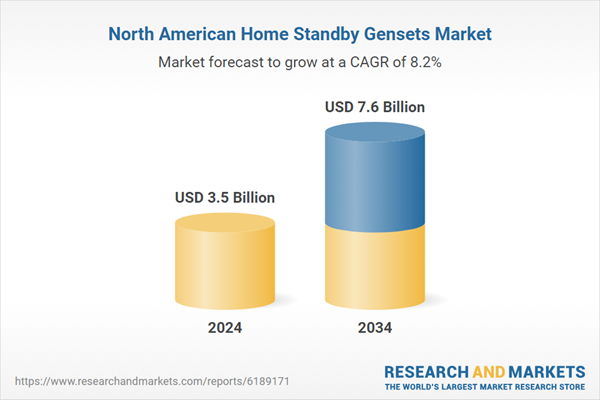The market is being driven by frequent power shortages, prolonged blackouts, rising consumer spending, and increasingly strict emissions standards. Severe weather events and a growing reliance on backup power to maintain daily household operations continue to boost demand for home standby generators. These systems are permanently installed and automatically provide electricity during grid outages, supporting essential appliances, lighting, and HVAC systems. Demand is cyclical, spiking after extreme weather events or major power disruptions, and moderating as households upgrade existing systems. Rising awareness of energy resilience, coupled with urban and suburban adoption, further strengthens market growth as homeowners prioritize uninterrupted power for safety, convenience, and comfort.
In 2024, 10 kVA home standby gensets held a 35% share and are expected to grow at a CAGR of 8.5% through 2034. Compact and ideal for smaller homes or urban residences, these generators are increasingly purchased in response to frequent storms and grid disruptions.
The three-phase home standby gensets will grow at a CAGR of 7% between 2025 and 2034, driven by larger residences and affluent households needing higher power capacity. These units offer robust performance for multiple appliances and HVAC systems, featuring quieter engines, fuel efficiency, advanced automatic transfer switches, and remote monitoring for reliability and convenience.
U.S. Home Standby Gensets Market held 85% share and generated USD 2.9 billion in 2024. Growing electricity outages, aging infrastructure, and heightened consumer awareness of energy resilience are driving adoption. Homeowners prioritize dependable backup systems to maintain daily operations, protect appliances, and support connected home technologies. Integration with smart home systems and IoT-enabled monitoring enhances convenience, energy management, and performance optimization.
Key players in the North America Home Standby Gensets Market include Generac Power Systems, Atlas Copco, Caterpillar, Cummins, HIMOINSA, Honeywell International, Kirloskar, Eaton, Champion Power Equipment, Rehlko, Aurora Generators, Sommers Generator Systems, KUBOTA Corporation, Blue Star Power Systems, WINCO, Honda Motor, HIPOWER SYSTEMS, Briggs and Stratton, and Total Power. Leading manufacturers are focusing on innovation in fuel-efficient and low-noise generators while integrating IoT and smart home compatibility to improve user experience. Strategic partnerships with utility providers, contractors, and distributors enhance market penetration and accessibility. Companies are expanding manufacturing and service networks across North America to reduce lead times and ensure quick installation and maintenance. Marketing campaigns highlight reliability, energy resilience, and uninterrupted power during outages to build brand trust. Some firms invest in advanced transfer switch technology and remote monitoring solutions to differentiate their products.
Comprehensive Market Analysis and Forecast
- Industry trends, key growth drivers, challenges, future opportunities, and regulatory landscape
- Competitive landscape with Porter’s Five Forces and PESTEL analysis
- Market size, segmentation, and regional forecasts
- In-depth company profiles, business strategies, financial insights, and SWOT analysis
This product will be delivered within 2-4 business days.
Table of Contents
Companies Mentioned
The companies profiled in this North America Home Standby Gensets market report include:- Atlas Copco
- Caterpillar
- Cummins
- Generac Power Systems
- HIMOINSA
- Kirloskar
- Honeywell International
- Eaton
- Champion Power Equipment
- Rehlko
- Aurora Generators
- Briggs and Stratton
- Sommers Generator Systems
- KUBOTA Corporation
- Xylem
- Honda Motor
- HIPOWER SYSTEMS
- WINCO
- Blue Star Power Systems
- Total Power
Table Information
| Report Attribute | Details |
|---|---|
| No. of Pages | 181 |
| Published | October 2025 |
| Forecast Period | 2024 - 2034 |
| Estimated Market Value ( USD | $ 3.5 Billion |
| Forecasted Market Value ( USD | $ 7.6 Billion |
| Compound Annual Growth Rate | 8.2% |
| Regions Covered | North America |
| No. of Companies Mentioned | 21 |









